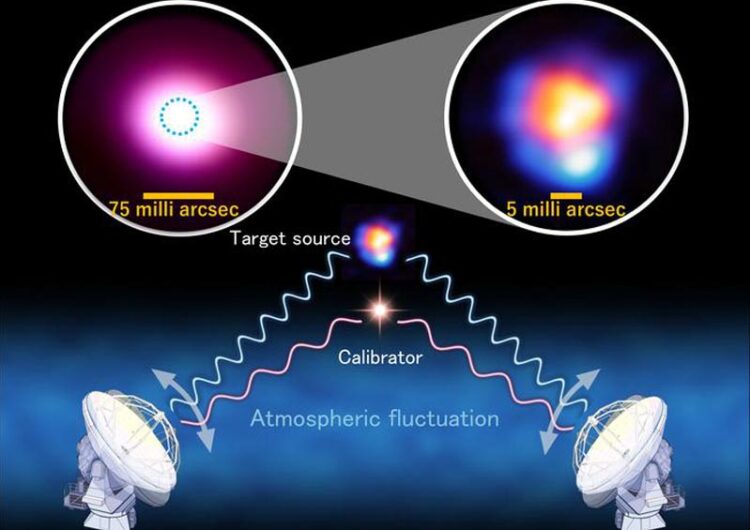ALMA demonstrates highest resolution yet

The Band-to-band (B2B) method demonstrated this time to achieve the highest resolution with ALMA. In the B2B method, atmospheric fluctuations are compensated for by observing a nearby calibrator in low frequency radio waves, while the target is observed with high frequency radio waves. The top right inset image shows the ALMA image of R Leporis that achieved the highest resolution of 5 milli-arcsec. Submillimeter-wave emissions from the stellar surface are shown in orange and hydrogen cyanide maser emissions at 891 GHz are shown in blue. The top left inset image shows a previous observation of the same star using a different array configuration with less distance between the antennas and without the B2B method, resulting in a resolution of 75 milli-arcsec. The previous resolution is too coarse to specify the positions of each of the two emission components.
Credit: ALMA (ESO/NAOJ/NRAO), Y. Asaki et al.
ALMA (Atacama Large Millimeter/submillimeter Array) has demonstrated the highest resolution yet with observations of an old star. The observations show that the star is surrounded by a ring-like structure of gas and that gas from the star is escaping to the surrounding space. Future observations with the newly demonstrated high resolution are expected to elucidate, not only the end of a star’s life, but also the beginning, when planets are still forming.
ALMA is a radio interferometric array telescope, in which individual antennas work together to observe a celestial object. ALMA’s resolution, the ability to see small details, is determined by the maximum separation between the antennas and the frequency of the observed radio waves. In this research, an international team comprised mainly of astronomers from the Joint ALMA Observatory, National Astronomical Observatory of Japan (NAOJ), National Radio Astronomy Observatory, and European Southern Observatory used ALMA’s maximum antenna separation of 16 km and highest frequency receivers (known as Band 10, up to 950 GHz) to achieve the best resolution possible.
Pushing ALMA’s resolution to new limits also required a new calibration technique to correct for fluctuations in Earth’s atmosphere above the antennas. The calibration technique the team used, known as “band-to-band (B2B),” was originally tested in the 1990s at Nobeyama Radio Observatory of NAOJ for future millimeter/submillimeter interferometers.
For their demonstration observations, the team chose R Leporis, a star in the final stage of stellar evolution, located approximately 1,535 light-years away from Earth. The team succeeded in observing R Leporis with the best resolution ever, 5 milli-arcsec, which is the equivalent of being able to see a single human hair two and a half miles away. The observations show the surface of the star and a ring of gas around the star. The team also confirmed that gas from the star is escaping to the surrounding space.
This newly demonstrated high resolution capability can now be applied to young stars with protoplanetary disks where planets are forming. Future high-resolution observations will provide new insights into how planets, particularly Earth-like planets, form.
Journal: The Astrophysical Journal
DOI: 10.3847/1538-4357/acf619
Method of Research: Observational study
Subject of Research: Not applicable
Article Title: ALMA High-frequency Long Baseline Campaign in 2021: Highest Angular Resolution Submillimeter Wave Images for the Carbon-rich Star R Lep
Article Publication Date: 15-Nov-2023
Media Contact
Naoko Inoue
NAOJ, NINS
naoko.inoue@nao.ac.jp
Original Source
https://www.nao.ac.jp/en/news/science/2023/20231115-alma.html
All latest news from the category: Physics and Astronomy
This area deals with the fundamental laws and building blocks of nature and how they interact, the properties and the behavior of matter, and research into space and time and their structures.
innovations-report provides in-depth reports and articles on subjects such as astrophysics, laser technologies, nuclear, quantum, particle and solid-state physics, nanotechnologies, planetary research and findings (Mars, Venus) and developments related to the Hubble Telescope.
Newest articles

Compact LCOS Microdisplay with Fast CMOS Backplane
…for High-Speed Light Modulation. Researchers from the Fraunhofer Institute for Photonic Microsystems IPMS, in collaboration with HOLOEYE Photonics AG, have developed a compact LCOS microdisplay with high refresh rates that…

New perspectives for material detection
CRC MARIE enters third funding period: A major success for terahertz research: Scientists at the University of Duisburg-Essen and the Ruhr University Bochum have been researching mobile material detection since…

CD Laboratory at TU Graz Researches New Semiconductor Materials
Using energy- and resource-saving methods, a research team at the Institute of Inorganic Chemistry at TU Graz aims to produce high-quality doped silicon layers for the electronics and solar industries….



